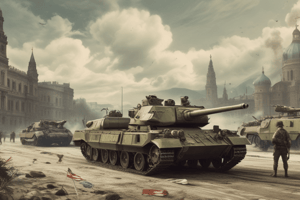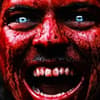Podcast
Questions and Answers
Which two countries provided significant military aid to the Nationalists during the Spanish Civil War?
Which two countries provided significant military aid to the Nationalists during the Spanish Civil War?
- Italy and France
- The Soviet Union and France
- Germany and the Soviet Union
- Germany and Italy (correct)
What was the outcome of the Spanish Civil War?
What was the outcome of the Spanish Civil War?
- The Nationalists defeated the Republicans and established a fascist dictatorship. (correct)
- The International Brigades took control of the government.
- The Republicans emerged victorious and established a democratic government.
- The war ended in a stalemate, with both sides agreeing to a power-sharing government.
What was the significance of the Spanish Civil War in the broader context of European politics?
What was the significance of the Spanish Civil War in the broader context of European politics?
- It marked the beginning of World War II.
- It was a precursor to World War II, with major powers testing their military strategies. (correct)
- It led to the formation of the European Union.
- It was a minor conflict with no international implications.
What was Hitler's role in Germany during the 1930s?
What was Hitler's role in Germany during the 1930s?
What was Hitler's policy towards the Treaty of Versailles?
What was Hitler's policy towards the Treaty of Versailles?
When did Germany's Emperor Kaiser Wilhelm II abdicate?
When did Germany's Emperor Kaiser Wilhelm II abdicate?
What was one of the main consequences of the Treaty of Versailles?
What was one of the main consequences of the Treaty of Versailles?
What was the name of the book written by Adolf Hitler while in prison?
What was the name of the book written by Adolf Hitler while in prison?
What event led to economic depression and Hitler's Nazi Party gaining popularity?
What event led to economic depression and Hitler's Nazi Party gaining popularity?
What was the name of the party that became the largest party in Germany's Parliament in 1931?
What was the name of the party that became the largest party in Germany's Parliament in 1931?
What was the name of the puppet state created by Japan in 1931?
What was the name of the puppet state created by Japan in 1931?
Who was the leader of the nationalist movement in the Spanish Civil War?
Who was the leader of the nationalist movement in the Spanish Civil War?
What was the name of the international organization established by the Treaty of Versailles?
What was the name of the international organization established by the Treaty of Versailles?
Which country invaded Abyssinia (Ethiopia) in 1935?
Which country invaded Abyssinia (Ethiopia) in 1935?
What was the name of the Olympic games where the Nazis were seen as a firm but fair government?
What was the name of the Olympic games where the Nazis were seen as a firm but fair government?
Flashcards are hidden until you start studying
Study Notes
Here is a summary of the text in detailed bullet points:
• September 1st, 1939: German troops invaded Poland, marking the beginning of World War II, 20 years after Germany's defeat in World War I.
• November 11th, 1918: World War I ended, and Germany's Emperor Kaiser Wilhelm II was forced to abdicate, with Germany facing starvation and defeat.
• 1919: The Treaty of Versailles was signed, establishing the League of Nations, aiming to resolve disputes between countries through debate, not fighting.
• Post-WWI: Germany was reduced in size, and new nations were created, including Austria, Poland, Hungary, Czechoslovakia, Yugoslavia, Lithuania, and Estonia.
• 1920s: Germany experienced hyperinflation, wiping out ordinary people's savings, creating fertile ground for right-wing politicians like Adolf Hitler.
• 1923: Hitler attempted a coup against the Weimar government, was sentenced to 9 months in prison, and wrote "Mein Kampf," blaming Jews for Germany's problems.
• 1929: The US Stock Market crashed, leading to economic depression, and Hitler's Nazi Party gained popularity.
• 1931: The Nazis became the largest party in Germany's Parliament, and Hitler was appointed Chancellor in 1933.
• 1933: Hitler declared himself President, and Germany began rearmament, violating the Treaty of Versailles.
• 1935: Hitler unveiled the Luftwaffe, and Germany reoccupied the Saar district, which voted to return to German rule.
• 1936: The Berlin Olympics took place, and the Nazis were seen as a firm but fair government, restoring national pride.
• 1930s: Japan faced economic problems, including a rapidly expanding population and lack of natural resources.
• 1931: Japan invaded Manchuria, creating a puppet state, and the League of Nations condemned Japan's actions, but took no effective action.
• 1936: Japan signed a pact with Hitler, and invaded China, leading to widespread atrocities and massacres.
• 1937: The Japanese attacked the USS Panay, killing 50 crewmen, but the Western Powers refused to intervene.
• 1930s: Italy, under Benito Mussolini, launched a series of aggressive military campaigns, including the invasion of Abyssinia (Ethiopia).
• 1934: Italian forces clashed with Abyssinian troops, and the League of Nations failed to take effective action.
• 1935: Italy invaded Abyssinia, and the Emperor of Abyssinia, Haile Selassie, appealed to the League of Nations, but it did nothing.
• 1936: Italian forces completely overran Abyssinia, and the Emperor fled into exile in Britain.
• 1930s: The Western Powers, Britain and France, were weakened by World War I and the Great Depression, and were unwilling to confront aggression.
• 1936: A Civil War erupted in Spain, and General Francisco Franco, with the support of Hitler and Mussolini, led a nationalist movement against the Republic.
• 1936: Hitler and Mussolini supported Franco's forces, and the Nationalist situation was transformed, leading to the defeat of the Republic.- The Spanish Civil War began in 1936, with the Nationalists, led by General Francisco Franco, fighting against the Republicans, who were supported by the Soviet Union.
-
Germany and Italy provided significant military aid to the Nationalists, while the Soviet Union provided aid to the Republicans.
-
The International Brigades, a group of volunteers from around the world, fought on the side of the Republicans.
-
The Nationalists, with the support of Germany and Italy, were able to gain the upper hand in the war, and by the end of 1938, they had penned the Republicans into a small enclave around Barcelona.
-
The war ended in March 1939, with the defeat of the Republicans and the establishment of a fascist dictatorship in Spain.
-
The Spanish Civil War was a precursor to World War II, with Germany, Italy, and the Soviet Union all involved and testing their military strategies.
-
Hitler's Nazi Party in Germany was rising to power, with Hitler becoming Chancellor in 1933 and then dictator in 1934.
-
Hitler began to rearm Germany, which was forbidden by the Treaty of Versailles, and secretly developed tanks and aircraft.
-
In 1935, Hitler revealed the existence of the Luftwaffe, and in 1936, he remilitarized the Rhineland, which was demilitarized under the Treaty of Versailles.
-
In 1938, Hitler annexed Austria, and then turned his attention to Czechoslovakia, where he demanded the annexation of the Sudetenland, a region with a German-speaking majority.
-
Britain and France, in an effort to appease Hitler, agreed to the annexation, and Hitler occupied the Sudetenland in October 1938.
-
Hitler then turned his attention to Poland, where he demanded the return of the port city of Danzig, which was under Polish control.
-
When Poland refused, Hitler invaded Poland on September 1, 1939, which led to the declaration of war by France and Britain on September 3, 1939.
-
The Soviet Union, under Stalin, had been watching Hitler's aggression with concern and proposed an alliance with Britain and France, but negotiations failed, and Stalin decided to make a non-aggression pact with Hitler instead.
-
The pact, signed on August 23, 1939, divided Eastern Europe into Soviet and German spheres of influence, and Hitler was free to invade Poland without fear of Soviet intervention.
Studying That Suits You
Use AI to generate personalized quizzes and flashcards to suit your learning preferences.




